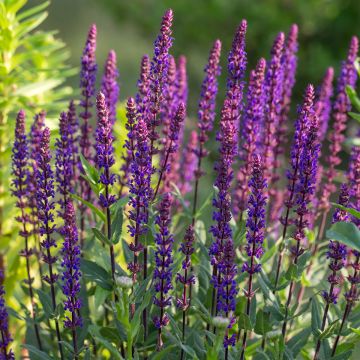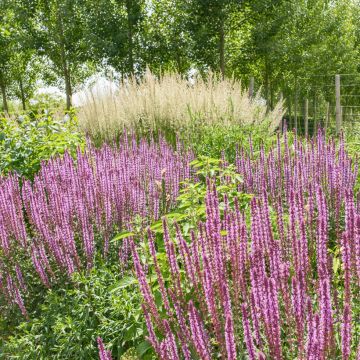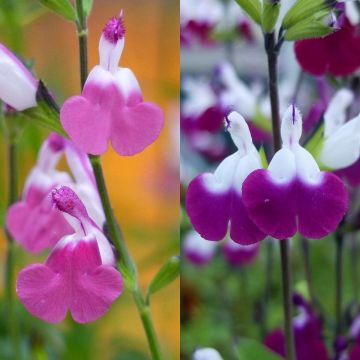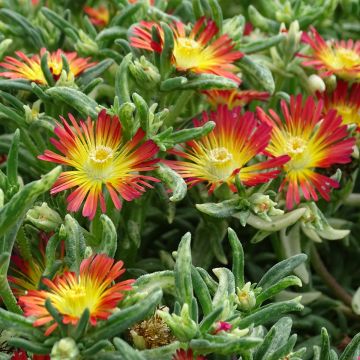

Salvia microphylla Gletsjer


Salvia microphylla Gletsjer
Salvia microphylla Gletsjer
Salvia microphylla Gletsjer
Sage
Lovely sage in the making, thank you to the team.
Nath44, 14/08/2025
Special offer!
Receive a €20 voucher for any order over €90 (excluding delivery costs, credit notes, and plastic-free options)!
1- Add your favorite plants to your cart.
2- Once you have reached €90, confirm your order (you can even choose the delivery date!).
3- As soon as your order is shipped, you will receive an email containing your voucher code, valid for 3 months (90 days).
Your voucher is unique and can only be used once, for any order with a minimum value of €20, excluding delivery costs.
Can be combined with other current offers, non-divisible and non-refundable.
Home or relay delivery (depending on size and destination)
Schedule delivery date,
and select date in basket
This plant carries a 12 months recovery warranty
More information
We guarantee the quality of our plants for a full growing cycle, and will replace at our expense any plant that fails to recover under normal climatic and planting conditions.
Would this plant suit my garden?
Set up your Plantfit profile →
Description
Salvia microphylla Gletsjer or Glacier is a variety of shrubby sage with a very bright presence in borders and pots on the terrace. Vigorous and bushy, it is adorned with pure white flowers during a long period that extends from spring to autumn, with a summer break if the summer is very dry. Its flowers enliven a semi-evergreen foliage composed of small leaves with a unique menthol scent. Fairly hardy, down to about -16°C (3.2°F), it is robust and only requires a very well-drained, even poor soil, in a sunny or semi-shaded position to thrive. Place it near a pathway, where you will brush against its highly aromatic foliage.
Salvia microphylla Gletsjer or Glacier is a beautiful selection derived from a shrubby botanical species called Graham's Sage. It belongs to the family of lamiaceae or labiates. The mountains of eastern, western and southern Mexico, as well as southern Arizona, are the birthplaces of this aromatic plant. Gletsjer or Glacier is a woody perennial plant that is well-branched and has a bushy habit. This variety reaches a height of 70 cm (28in) with a width of 50 cm. The nectar-rich flowering is particularly abundant, especially in autumn from September to November if the cold does not put an end to it. This sage blooms once in spring and a second time in autumn after a break in a hot and dry summer. In regions where the summer is reasonably rainy, the flowering is uninterrupted. The elongated flowers emerge from the foliage, grouped in spikes on green stems. They measure no more than 2 cm (1in) in length and are a very bright pure white that catches the eye in the garden. They only last for a day but are already replaced the next morning. The semi-evergreen foliage is composed of small oval leaves with wavy edges, of a fairly tender green colour, thick and aromatic, slightly sticky, releasing a strongly mentholated and acidulated essential oil in the heat.
This sage brings life to any flower bed for almost 6 months. It accompanies spring blooms of Cistus, Rosemary, and Rock Bellflowers. In summer, it is sublime alongside the silver foliage of Cotton Lavenders, Helichrysum italicum, or shrubby Wormwoods. Its association with autumn asters is fabulous: choose those that are easy to grow, such as Aster laevis, Aster turbinellus, or Aster amellus, for example. Gauras, tall Sedums, and shrubby Potentillas create a charming tableau with it.
In Mexico, a delicious tea is made from the leaves of this sage, which is called 'mountain myrtle' there.
Report an error about the product description
Salvia microphylla Gletsjer in pictures




Flowering
Foliage
Plant habit
Botanical data
Salvia
microphylla
Gletsjer
Lamiaceae
Sage
Cultivar or hybrid
Other Salvia - Sage
View all →Planting and care
Plant Salvia microphylla Gletsjer after spring frosts in a cold climate, in September-October in a warm climate. Place it in a light, ordinary, porous, rocky, even limestone soil, not too poor to support its flowering. This plant prefers sunny situations or partial shade. It requires regular watering from spring to autumn to flower abundantly. In very dry summers, the flowering diminishes. In poor soil, incorporate a little well-rotted compost or leaf mold. Place it in the warmest corner of the garden, in full sun, against a south-facing wall, in a rocky or sandy slope, in any substrate that does not retain too much moisture. Under these conditions, it can withstand short frosts of around -15 °C. It thrives well in container cultivation, allowing gardeners to store it over winter.
Planting period
Intended location
Care
-
, onOrder confirmed
Reply from on Promesse de fleurs
Similar products
Haven't found what you were looking for?
Hardiness is the lowest winter temperature a plant can endure without suffering serious damage or even dying. However, hardiness is affected by location (a sheltered area, such as a patio), protection (winter cover) and soil type (hardiness is improved by well-drained soil).

Photo Sharing Terms & Conditions
In order to encourage gardeners to interact and share their experiences, Promesse de fleurs offers various media enabling content to be uploaded onto its Site - in particular via the ‘Photo sharing’ module.
The User agrees to refrain from:
- Posting any content that is illegal, prejudicial, insulting, racist, inciteful to hatred, revisionist, contrary to public decency, that infringes on privacy or on the privacy rights of third parties, in particular the publicity rights of persons and goods, intellectual property rights, or the right to privacy.
- Submitting content on behalf of a third party;
- Impersonate the identity of a third party and/or publish any personal information about a third party;
In general, the User undertakes to refrain from any unethical behaviour.
All Content (in particular text, comments, files, images, photos, videos, creative works, etc.), which may be subject to property or intellectual property rights, image or other private rights, shall remain the property of the User, subject to the limited rights granted by the terms of the licence granted by Promesse de fleurs as stated below. Users are at liberty to publish or not to publish such Content on the Site, notably via the ‘Photo Sharing’ facility, and accept that this Content shall be made public and freely accessible, notably on the Internet.
Users further acknowledge, undertake to have ,and guarantee that they hold all necessary rights and permissions to publish such material on the Site, in particular with regard to the legislation in force pertaining to any privacy, property, intellectual property, image, or contractual rights, or rights of any other nature. By publishing such Content on the Site, Users acknowledge accepting full liability as publishers of the Content within the meaning of the law, and grant Promesse de fleurs, free of charge, an inclusive, worldwide licence for the said Content for the entire duration of its publication, including all reproduction, representation, up/downloading, displaying, performing, transmission, and storage rights.
Users also grant permission for their name to be linked to the Content and accept that this link may not always be made available.
By engaging in posting material, Users consent to their Content becoming automatically accessible on the Internet, in particular on other sites and/or blogs and/or web pages of the Promesse de fleurs site, including in particular social pages and the Promesse de fleurs catalogue.
Users may secure the removal of entrusted content free of charge by issuing a simple request via our contact form.
The flowering period indicated on our website applies to countries and regions located in USDA zone 8 (France, the United Kingdom, Ireland, the Netherlands, etc.)
It will vary according to where you live:
- In zones 9 to 10 (Italy, Spain, Greece, etc.), flowering will occur about 2 to 4 weeks earlier.
- In zones 6 to 7 (Germany, Poland, Slovenia, and lower mountainous regions), flowering will be delayed by 2 to 3 weeks.
- In zone 5 (Central Europe, Scandinavia), blooming will be delayed by 3 to 5 weeks.
In temperate climates, pruning of spring-flowering shrubs (forsythia, spireas, etc.) should be done just after flowering.
Pruning of summer-flowering shrubs (Indian Lilac, Perovskia, etc.) can be done in winter or spring.
In cold regions as well as with frost-sensitive plants, avoid pruning too early when severe frosts may still occur.
The planting period indicated on our website applies to countries and regions located in USDA zone 8 (France, United Kingdom, Ireland, Netherlands).
It will vary according to where you live:
- In Mediterranean zones (Marseille, Madrid, Milan, etc.), autumn and winter are the best planting periods.
- In continental zones (Strasbourg, Munich, Vienna, etc.), delay planting by 2 to 3 weeks in spring and bring it forward by 2 to 4 weeks in autumn.
- In mountainous regions (the Alps, Pyrenees, Carpathians, etc.), it is best to plant in late spring (May-June) or late summer (August-September).
The harvesting period indicated on our website applies to countries and regions in USDA zone 8 (France, England, Ireland, the Netherlands).
In colder areas (Scandinavia, Poland, Austria...) fruit and vegetable harvests are likely to be delayed by 3-4 weeks.
In warmer areas (Italy, Spain, Greece, etc.), harvesting will probably take place earlier, depending on weather conditions.
The sowing periods indicated on our website apply to countries and regions within USDA Zone 8 (France, UK, Ireland, Netherlands).
In colder areas (Scandinavia, Poland, Austria...), delay any outdoor sowing by 3-4 weeks, or sow under glass.
In warmer climes (Italy, Spain, Greece, etc.), bring outdoor sowing forward by a few weeks.



















































